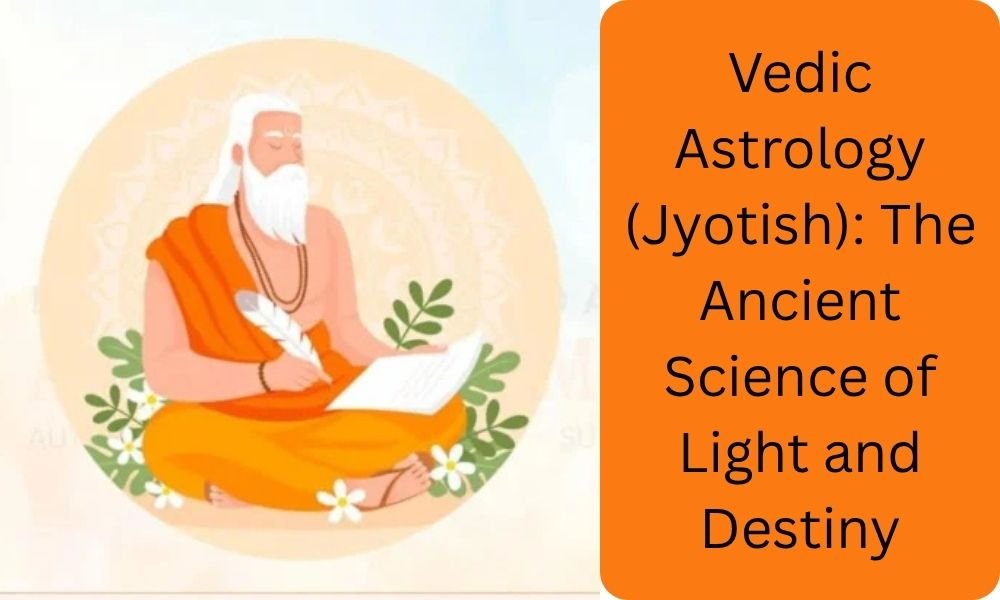Vedic astrology, or Jyotish Shastra, is more than just a system of predicting the future; it is a profound spiritual science that connects the human soul to the universe. Originating from the sacred Vedas of ancient India, Jyotish is often referred to as the “eye of the Vedas” (Vedachakshu), as it provides insight into life’s purpose, karma, and the subtle connection between the cosmos and human destiny.
🌞 Origins and Foundation
The word Jyotish comes from the Sanskrit word “Jyoti”, meaning light, symbolizing illumination and divine guidance. Rooted in the Vedic tradition, Jyotish is one of the six Vedangas (limbs of the Vedas) and is considered essential for understanding time and destiny.
According to ancient seers (Rishis), the positions of planets and stars at the moment of a person’s birth hold the key to understanding their karmic patterns and life journey. It is believed that through Jyotish, one can navigate life’s challenges and align with their higher spiritual path.
This ancient discipline is closely related to Yoga and Ayurveda, forming a triad of knowledge that leads to holistic well-being — balancing body, mind, and spirit.
🔭 Key Elements of Vedic Astrology
1. Birth Chart (Janma Kundali)
The cornerstone of Jyotish is the birth chart, or Janma Kundali. It maps the exact positions of celestial bodies — the Sun, Moon, planets, and constellations at the time of birth. Each placement reveals insights into a person’s strengths, weaknesses, destiny, and spiritual lessons.
Astrologers analyze the twelve houses in the chart to interpret areas like career, relationships, health, and spiritual evolution.
2. Nakshatras (Lunar Mansions)
The Moon, which represents the mind, moves through 27 Nakshatras or lunar mansions. Each Nakshatra has its unique vibration and symbolism, influencing personality traits and emotional tendencies. For example, Rohini Nakshatra is known for creativity and charm, while Ashwini symbolizes healing and initiative.
3. Dasha System (Planetary Periods)
One of the most distinctive aspects of Vedic astrology is the Dasha system, a time-based method that shows which planets influence certain phases of life.
For instance, the Mahadasha (major period) of Saturn may bring responsibility and discipline, while Venus might bring love and luxury. This system helps individuals understand timing when to act, reflect, or change direction.
🌌 How Vedic Astrology Differs from Western Astrology
While both Vedic and Western astrology study planetary positions, they differ in fundamental ways:
- Zodiac System:
Vedic astrology uses the sidereal zodiac (based on fixed stars), whereas Western astrology uses the tropical zodiac (based on the Sun’s position relative to the equinoxes).
This difference means your Vedic Sun sign might not match your Western one. - Focus and Philosophy:
Vedic astrology emphasizes karma, dharma, and moksha (liberation), viewing life as a journey of soul evolution. Western astrology often focuses on psychological insights and personal growth.
🌠 Applications of Jyotish in Daily Life
1. Guidance for Life Decisions
Vedic astrology is often consulted for key life choices, marriage compatibility, career moves, travel, or health decisions. By understanding planetary influences, one can choose auspicious moments (muhurta) and make decisions in harmony with cosmic timing.
2. Self-Understanding and Growth
The birth chart acts like a mirror of the soul, helping individuals understand their emotional patterns, karmic lessons, and innate gifts. It’s a roadmap to personal evolution, guiding one to live more consciously.
3. Spiritual Alignment
Jyotish encourages individuals to align their actions with divine will. By following planetary rhythms and remedies like mantras, gemstones, or meditation, one can balance energies and progress spiritually.
📚 Jyotish in Modern Times
Today, Vedic astrology is practiced worldwide, from traditional astrologers in India to spiritual seekers in the West. Modern technology has made free Vedic birth chart calculators and apps widely available, allowing people to explore their charts instantly.
Popular books and courses on Jyotish teach how to interpret charts, understand planetary yogas, and apply ancient wisdom to modern life. Despite its ancient roots, Jyotish continues to offer timeless insights for those seeking meaning, purpose, and spiritual clarity.
🌺 Conclusion
Vedic astrology, or Jyotish, is more than fortune-telling; it’s a pathway to enlightenment. It teaches that life is guided by a cosmic rhythm, and understanding that rhythm helps us live with greater awareness and grace.
In the same way that the German term Nativität reflects one’s birth and destiny, Jyotish too illuminates the sacred connection between our birth moment and the universe’s divine design.

